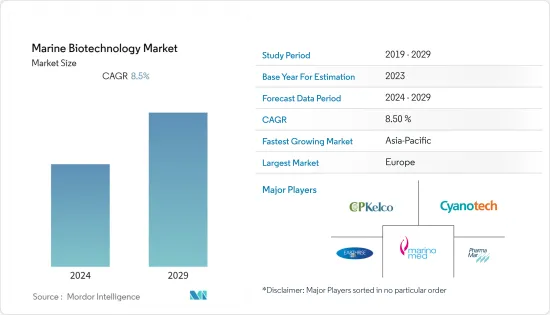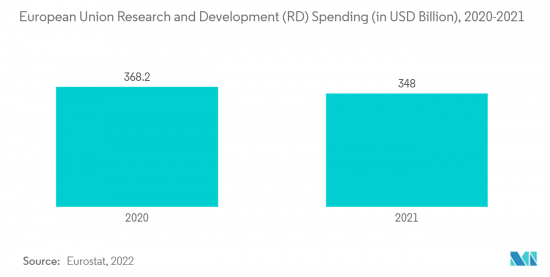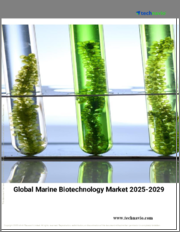
|
시장보고서
상품코드
1406902
해양 바이오테크놀러지 시장 : 점유율 분석, 산업 동향 및 통계, 성장 예측(2024-2029년)Marine Biotechnology - Market Share Analysis, Industry Trends & Statistics, Growth Forecasts 2024 - 2029 |
||||||
해양 바이오테크놀러지(Marine Biotechnology) 시장은 예측 기간 동안 CAGR 8.5%로 추이하며 성장 할 것으로 예상됩니다.
COVID-19 팬데믹은 초기 단계에서 해양 바이오테크놀러지 산업의 수요와 생산에 영향을 미쳤습니다. 반면, COVID-19 감염에 대한 잠재적인 건강상의 이점을 제공하는 해양 유래 보충제의 생산은 팬데믹으로 인해 더욱 활발해졌습니다. 예를 들어, 2022년 2월 항산화제 저널에 게재된 논문에 따르면, 여러 해양 조류 종은 잠재적인 항바이러스 및 면역 조절 활성을 가진 생리 활성 대사산물을 위해 활용되고 있습니다. 따라서 팬데믹 기간 동안 해양 유래 보충제의 사용이 급증하면서 시장 성장에 큰 영향을 미쳤습니다. 그러나 COVID-19 사례 수가 감소함에 따라 해양 바이오테크놀러지 시장은 안정적인 성장을 이루었습니다.

제약, 화장품, 식품 및 농업과 같은 다양한 산업에서 해조류 및 균류와 같은 해양 생물의 사용이 증가하는 것은 해양 바이오테크놀러지 시장의 성장을 촉진하는 주요 요인입니다. 예를 들어, 2021년 7월 인도 국립해양기술연구소의 과학자 팀은 심해 박테리아의 도움으로 화장품을 만들기 위한 노화 방지 성분을 개발했습니다. 또한 미국, 독일, 영국 등 선진국에서는 해양에서 추출한 영양 보충제에 대한 수요가 증가하고 있습니다. 2022년 2월 '해양과학 프론티어 저널'에 실린 논문에 따르면, 혹독한 환경 조건에서 번성하는 특정 해양 미생물은 항산화, 항균, 세포사멸, 항종양, 항바이러스 화학물질을 생산해 건강 유지 및 만성질환 예방을 위한 기능성 식품 원료 생산에 활용될 수 있다고 합니다. 영양 보충제 생산을위한 해양 자원 활용의 증가는 예측 기간 동안 시장 성장에 추가 될 것으로 예상됩니다. 또한 유아에게는 높은 수준의 고도 불포화 지방산 섭취가 권장됩니다. 이러한 건강한 지방산은 해양 미세 조류 종에 의해 대량으로 생산됩니다. 어업, 신약 개발 및 양식 분야의 발전과 다양한 산업에서 해양 생물의 미개발 잠재력과 사용에 대한 인식이 높아짐에 따라 해양 바이오테크놀러지 소스에 대한 수요가 곧 증가 할 것으로 예상됩니다.
그러나 해양 탐사 부족과 실험실 조건 하에서 해양 미생물을 배양하는 제한된 능력은 예측 기간 동안 시장 성장을 제한할 가능성이 높습니다.
해양 바이오테크놀러지 시장 동향
의료 및 의약품 부문이 예측 기간 동안 큰 성장을 기록할 전망
의료 및 의약품 부문은 분석 기간 동안 큰 시장 점유율을 차지할 것으로 예상됩니다. 현재 미생물 유래의 의약품은 감염과 만성 질환의 치료에 점점 더 많이 사용되고 있습니다. 가장 일반적으로 사용되는 미생물 유래 약물은 페니실린, 액티노마이신, 세팔로스포린, 스트렙토마이신, 시클로스포린입니다.
해양 생물을 이용한 다양한 질병에 대한 다양한 치료제의 생산과 관련된 조사 활동 증가는 이 부문의 성장을 뒷받침할 것으로 예상됩니다. 예를 들어, 2021년 1월, 캘리포니아 대학의 과학자들은 해양 환경에서 구조적으로 다양한 천연 화합물을 확인했습니다. 이들 화합물은 항바이러스 치료제의 개발에 도움이 될 것으로 기대됩니다. 또한 2022년 3월에 Biotechnology in Healthcare Journal에 게재된 연구에 의하면, 영양학적·약리학적 특성을 가진 11,000 가까이의 천연 효과가 해초에서 보고되었습니다. 미세조류와 대형 조류에서 발견된 많은 화합물은 항균성, 항진균성, 항바이러스성, 항헤르페스성, 항산화성, 혈당 강하성과 같은 중요한 약리학적 특성을 가지고 있습니다.
기술의 발전으로 해양 생물의 배양 능력이 향상되었습니다. 예를 들어, 2021년 4월 일본 과학자들은 처음으로 안정된 산호 세포주 배양에 성공했습니다. 이러한 진보와 제약업계에서 해양생물의 이용에 관한 연구활동 증가는 해양생물로부터 다양한 바이오머티리얼을 생산하는 새로운 길을 열 것으로 기대됩니다. 이로 인해 의료 및 제약 산업에서 해양 바이오테크놀러지 수요를 촉진할 수 있습니다.

예측 기간 동안 유럽이 해양 바이오테크놀러지 시장에서 큰 점유율을 차지할 전망
유럽은 예측 기간 동안 상당한 시장 점유율을 차지할 것으로 예상됩니다. 천연 해양 제품의 사용을 촉진하기위한 정부의 지원과 이러한 제품 개발을위한 자금의 가용성은 예측 기간 동안 독일의 시장 성장을 촉진하는 데 도움이 될 것입니다. 예를 들어, 2021년 3월, 독일에 본사를 둔 생명공학 회사인 Bluu Biosciences는 세포 배양으로 고품질의 지속 가능한 수산물을 생산하기 위해 약 700만 유로(780만 달러)를 지원받았습니다.
정교한 건강 관리 인프라의 존재, 해양 바이오테크놀러지의 기술적 진보, 제약 및 화장품 산업에서 해양 생물 수요가 증가하는 것은 유럽에서 해양 바이오테크놀러지 수요가 높은 주요 요인입니다. 예를 들어, 2021년 3월, Sea4Us는 해양 생물 생산물의 도움으로 비 오피오이드 진통제인 만성 통증 치료제의 개발을 계획하고 있습니다. 이 회사는 유럽 위원회가 지원하는 많은 프로젝트를 수행했습니다.
따라서 위에서 언급 한 요인과 유럽의 대규모 해양 양식업은 유럽에서 시장의 성장을 촉진 할 것으로 예상됩니다.
해양 바이오테크놀러지 산업 개요
해양 바이오테크놀러지 시장은 적당한 경쟁을 하고 있으며 BASF SE, AstaReal, Aker Biomarine, Euglena, Cyanotech Corporation, Earthrise Nutritionals LLC 등 수많은 선도 기업들로 구성되어 있습니다.
기타 혜택 :
- 엑셀 형식 시장 예측(ME) 시트
- 3개월간 애널리스트 서포트
목차
제1장 서론
- 조사 전제 조건 및 시장 정의
- 조사 범위
제2장 조사 방법
제3장 주요 요약
제4장 시장 역학
- 시장 개요
- 시장 성장 촉진 요인
- 의약품 및 화장품 업계에서 해양 생물의 이용 증가
- 해양 유래의 영양 보조 식품에 대한 수요 증가
- 수산·의약품 개발 분야의 진보
- 시장 성장 억제 요인
- 해양 탐사의 부족
- 연구소에서 해양 미생물의 배양 능력의 한계
- Porter's Five Forces 분석
- 공급기업의 협상력
- 구매자/소비자의 협상력
- 신규 참가업체의 위협
- 대체품의 위협
- 경쟁 기업간 경쟁 관계의 강도
제5장 시장 세분화
- 유래별
- 산호와 해면
- 조류
- 해양 바이러스
- 해양균류
- 기타 유래
- 최종 사용자별
- 의료·제약
- 식품산업
- 화장품 산업
- 화학업계
- 기타 최종 사용자
- 지역
- 북미
- 미국
- 캐나다
- 멕시코
- 유럽
- 독일
- 영국
- 프랑스
- 이탈리아
- 스페인
- 기타 유럽
- 아시아 태평양
- 중국
- 일본
- 인도
- 호주
- 한국
- 기타 아시아 태평양
- 중동 및 아프리카
- GCC
- 남아프리카공화국
- 기타 중동 및 아프리카
- 남미
- 브라질
- 아르헨티나
- 기타 남미
- 북미
제6장 경쟁 구도
- 기업 개요
- BASF SE
- AstaReal Co., Ltd.
- Aker Biomarine
- Euglena Co.,Ltd.
- Cyanotech Corporation
- Earthrise Nutritionals LLC
- CP Kelco US, Inc
- Bluebiotech International GmbH
- Marinomed Biotech AG
- PharmaMar SA
제7장 시장 기회 및 향후 동향
LYJ 24.01.29
The marine biotechnology market is expected to register a CAGR of 8.5% over the forecast period.
The COVID-19 pandemic affected demand and production in the marine biotechnology industry during the initial phase. On the other hand, the pandemic aided the production of marine-derived supplements since they provided potential health benefits against the COVID-19 infection. For instance, as per the article published in the Journal of Antioxidants in February 2022, several marine algae species have been utilized for their bioactive metabolites with potential antiviral and immunomodulatory activities. Thus, the surging use of marine-derived supplements during the pandemic significantly impacted the market growth. However, with the decrease in number of COVID-19 cases, the marine biotechnology market has gained stable growth and is expected to do the same during the forecast period.
The increase in the usage of marine organisms, such as algae and fungi, in different industries, such as pharmaceuticals, cosmetics, food, and agriculture, is a major factor boosting the growth of the marine biotechnology market. For instance, in July 2021, a team of scientists from the National Institute of Ocean Technology, India, developed an anti-ageing ingredient for making cosmetics with the help of deep-sea bacteria. Furthermore, there is an increasing demand for marine-derived nutritional supplements in developed countries such as the United States, Germany, and the United Kingdom. According to an article published in the Journal of Frontiers in Marine Science in February 2022, certain marine microbes which thrive in harsh environmental conditions produce antioxidant, antibacterial, apoptotic, antitumoral, and antiviral chemicals, which could be used in the production of functional food ingredients for health maintenance and chronic disease prevention. The rise in the utilization of marine resources for the production of nutritional supplements is expected to add to the market's growth during the forecast period. Moreover, high dietary levels of polyunsaturated fatty acids are recommended for infants. These healthy fatty acids are produced in large quantities by marine microalgal species. Advancements in the fields of fisheries, drug discovery, and aquaculture and an increase in awareness regarding the untapped potential and use of marine organisms in different industries are expected to increase demand for marine biotechnology sources shortly.
However, the lack of exploration of the oceans and the limited ability to culture marine microorganisms in laboratory conditions will likely restrict the market's growth during the forecast period.
Marine Biotechnology Market Trends
The Medical and Pharmaceutical Segment is Expected to Register the Significant Growth Over the Forecast Period
The medical and pharmaceutical segment is anticipated to hold a significant market share over the analysis period. Currently, microbially derived drugs are increasingly being used in the treatment of infectious diseases and chronic diseases. The most commonly used microbially derived drugs are penicillin, actinomycin, cephalosporins, streptomycin, and cyclosporin.
The increase in research activities related to using marine organisms to produce different therapeutics for various diseases is expected to boost the segment's growth. For instance, in January 2021, scientists at the University of California identified structurally diverse natural compounds in the marine environment. These compounds are expected to help in the development of antiviral therapeutics. Moreover, according to the study published in Biotechnology in Healthcare Journal in March 2022, nearly 11,000 natural effects with nutrition and pharmacological properties have been reported in marine algae. Many compounds found in micro and macroalgae have critical pharmacological properties, such as antibacterial, antifungal, antiviral, antiherpetic, antioxidative, and hypoglycemic properties.
With the advancement in technology, the ability to culture marine organisms has improved. For instance, in April 2021, scientists in Japan successfully cultured the first stable coral cell lines. Such advancement and increased research activities related to using marine organisms in the pharmaceutical industry are expected to open new avenues for producing different biomaterials from marine organisms. This, in turn, can promote the demand for marine biotechnology in the medical and pharmaceutical industries.

Europe is Expected to Hold a Significant Share in the Marine Biotechnology Market Over the Forecast Period
Europe is expected to hold a significant market share throughout the forecast period. The government's support to promote the use of natural marine products and the availability of funding for developing these products will help boost the market growth in Germany during the forecast period. For instance, in March 2021, Bluu Biosciences, a German-based biotech firm, received almost EUR 7 million (USD 7.8 million) to produce high-quality, sustainable fish products from cell cultures.
The presence of sophisticated healthcare infrastructure, technological advancements in marine biotechnology, and the growing demand for marine organisms in the pharmaceutical and cosmetic industries are major factors for the high demand for marine biotechnology in Europe. For instance, in March 2021, Sea4Us planned on developing a remedy for chronic pain, a non-opioid analgesic, with the help of marine bioproducts. The company has worked on many European Commission-supported projects.
Hence, the factors mentioned above and the large marine-farming operations in Europe are expected to boost the market's growth in Europe.
Marine Biotechnology Industry Overview
The marine biotechnology market is moderately competitive and consists of a large number of major players, including BASF SE, AstaReal Co., Ltd., Aker Biomarine, Euglena Co., Ltd., Cyanotech Corporation, and Earthrise Nutritionals LLC, among others.
Additional Benefits:
- The market estimate (ME) sheet in Excel format
- 3 months of analyst support
TABLE OF CONTENTS
1 INTRODUCTION
- 1.1 Study Assumptions and Market Definition
- 1.2 Scope of the Study
2 RESEARCH METHODOLOGY
3 EXECUTIVE SUMMARY
4 MARKET DYNAMICS
- 4.1 Market Overview
- 4.2 Market Drivers
- 4.2.1 Increase in the Usage of Marine Organisms in the Pharmaceutical and Cosmetic Industries
- 4.2.2 Increasing Demand for Marine-Derived Nutritional Supplements
- 4.2.3 Advancements in the Field of Fisheries and Drug Discovery
- 4.3 Market Restraints
- 4.3.1 Lack of Exploration in Oceans
- 4.3.2 Limited Ability to Culture Marine Micro-organisms in Laboratories
- 4.4 Porter's Five Forces Analysis
- 4.4.1 Bargaining Power of Suppliers
- 4.4.2 Bargaining Power of Buyers/Consumers
- 4.4.3 Threat of New Entrants
- 4.4.4 Threat of Substitute Products
- 4.4.5 Intensity of Competitive Rivalry
5 MARKET SEGMENTATION (Market Size by Value - USD)
- 5.1 By Source
- 5.1.1 Corals and Sponges
- 5.1.2 Algae
- 5.1.3 Marine Viruses
- 5.1.4 Marine Fungi
- 5.1.5 Other Sources
- 5.2 By End User
- 5.2.1 Medical and Pharmaceutical
- 5.2.2 Food Industry
- 5.2.3 Cosmetics Industry
- 5.2.4 Chemical Industry
- 5.2.5 Other End Users
- 5.3 Geography
- 5.3.1 North America
- 5.3.1.1 United States
- 5.3.1.2 Canada
- 5.3.1.3 Mexico
- 5.3.2 Europe
- 5.3.2.1 Germany
- 5.3.2.2 United Kingdom
- 5.3.2.3 France
- 5.3.2.4 Italy
- 5.3.2.5 Spain
- 5.3.2.6 Rest of Europe
- 5.3.3 Asia-Pacific
- 5.3.3.1 China
- 5.3.3.2 Japan
- 5.3.3.3 India
- 5.3.3.4 Australia
- 5.3.3.5 South Korea
- 5.3.3.6 Rest of Asia-Pacific
- 5.3.4 Middle-East and Africa
- 5.3.4.1 GCC
- 5.3.4.2 South Africa
- 5.3.4.3 Rest of Middle-East and Africa
- 5.3.5 South America
- 5.3.5.1 Brazil
- 5.3.5.2 Argentina
- 5.3.5.3 Rest of South America
- 5.3.1 North America
6 COMPETITIVE LANDSCAPE
- 6.1 Company Profiles
- 6.1.1 BASF SE
- 6.1.2 AstaReal Co., Ltd.
- 6.1.3 Aker Biomarine
- 6.1.4 Euglena Co.,Ltd.
- 6.1.5 Cyanotech Corporation
- 6.1.6 Earthrise Nutritionals LLC
- 6.1.7 CP Kelco U.S., Inc
- 6.1.8 Bluebiotech International GmbH
- 6.1.9 Marinomed Biotech AG
- 6.1.10 PharmaMar SA















